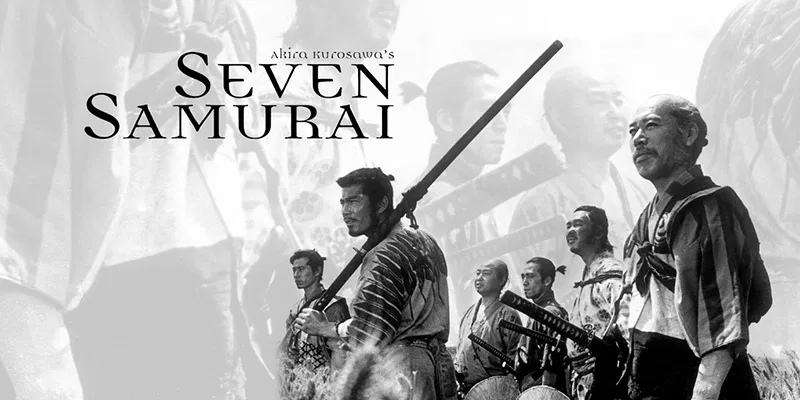 Akira Kurosawa’s Seven Samurai remains engaging despite being 66 years old. The story follows seven ronin, masterless samurai, as they defend a farming village from a band of starving bandits who want to steal the village’s rice and women. The film outlines the wrangling of the samurai’s pay to the final defense of the village. The pace of the first half of this long film (nearly 4 hours) may be slow for some. It establishes the personalities of each of the samurai and how they relate to each other.
Akira Kurosawa’s Seven Samurai remains engaging despite being 66 years old. The story follows seven ronin, masterless samurai, as they defend a farming village from a band of starving bandits who want to steal the village’s rice and women. The film outlines the wrangling of the samurai’s pay to the final defense of the village. The pace of the first half of this long film (nearly 4 hours) may be slow for some. It establishes the personalities of each of the samurai and how they relate to each other.
The film takes place during the Sengoku period, Japan’s warring states period, just before the establishment of the Tokugawa Shogunate and the Edo period.

Toshiro Mifune plays the temperamental and energetic Kikuchiyo, a farmer who lies about being a samurai. Mifune’s rambunctious character is exhausting to watch with how lively and all-over the screen he is. His character counterbalances the more controlled and Stoic samurai. He often expresses the thoughts and emotions they cannot. As you can expect, each of the samurai have a particular trait that sets them apart.
Takeshi Shimura plays Kambei Shimada, an experienced elder samurai who becomes their leader because of his experience and knowledge.
Daisuke Kato plays Shichoroji, Kambei’s friend and former Lieutenant. Shichiroji has the least development, but he is stalwart, experienced, and knows how to handle scared farmers turned scared militia.

Isao Kimura takes the role of Katsushiro Okamoto, the most developed character next to Kikuchiyo. Inexperienced, idealistic, and young, he becomes the adopted son of the more experienced samurai. Katsushiro falls in love with a young farm women named Shino (Keiko Tsushima), and they have a one-night stand on the eve of the final battle. Because of their difference in status, their love affair is doomed. Shino becomes damaged goods in the eyes of her father because she gave up her virginity before marriage, making it harder for her to marry in the future.At the same time, the event raises Katsushiro into the status of a man, finishing his rites when he kills his first man in battle. The film handles this interplay of expectations with how Shino’s father reacts to the discovery. In a way, Katsushiro’s rise in status is because he took a piece of Shino’s honor for himself. Remember, that this was a period when women were valued property.
Minoru Chiaki plays Heihachi Hayashida, a samurai who makes up for his lack of skill with this friendliness and morale boosting charm. He plays a role in training the farmers to fight and keeping fear from overwhelming them.
Seiji Miyaguchi plays a serious, taciturn but skilled swordsman. He says little, but his presence and ability firmly establishes the idea we have of film samurai.
Finally, Yoshio Inaba plays Gorobei Katayama, an archer, who helps make the plan for the village’s defense. Gorobei’s character is much like Shichiroji, a reliable person who doesn’t stand out yet gets the job done.

The film has helped frame how people view samurai, and you can see many references in anime to this film. Mugen from Samurai Champloo, for example, shares much of the same behavior as Kikuchiyo. While Seven Samurai doesn’t establish the tropes of samurai behavior–hero stories and literature handles that–it helped popularize the tropes.
Modern watchers may be put off by the film. First, it is black and white. I’ve encountered many people who are turned off by black and white films. This is unfortunate since many of the best films are black and white. Second, the film is subtitled. For most of us anime fans, that isn’t a big deal. But, again, many people struggle to watch and read subtitles at the same time. Third, the film is chaotic! It captures the frantic feel and chaos that battles must have had, particularly when you have hurriedly trained farmers who have never killed before. No one walks in this film. Everyone runs. You also see masses of people within most scenes. Farmers cluster and run in disorganized mobs. Sometimes, with the mist, smoke, dust, and the black and white film, it can be difficult to see which characters are in the scene. Except perhaps Mifune, who always stands out with his bombastic role. But this works in the film’s favor, capturing the tension and confusion of war.

The film’s pacing also reflects this. There’s many quiet scenes of people tensely waiting for the next attack. The film captures the fear such uncertainty creates. These long shots act as punctuation marks between scenes, allowing the audience to rest for a moment too.
Mifune’s performance feels a little cheesy by today’s standards, but it works for his character, who has something to prove. His performance also keeps the film from getting dull with the more stoic characters. He is always up to something! Don’t let the long running time or the fact it is black and white scare you off. Seven Samurai is worth the watch and the acclaim it receives. Every anime fan who writes about the medium need to give the film a watch too. The way Mifune behaves captures many shonen heroes. Seven Samurai offers a more accessible glimpse at common characters found in samurai literature. And this literature underpins some of what we see in anime.



